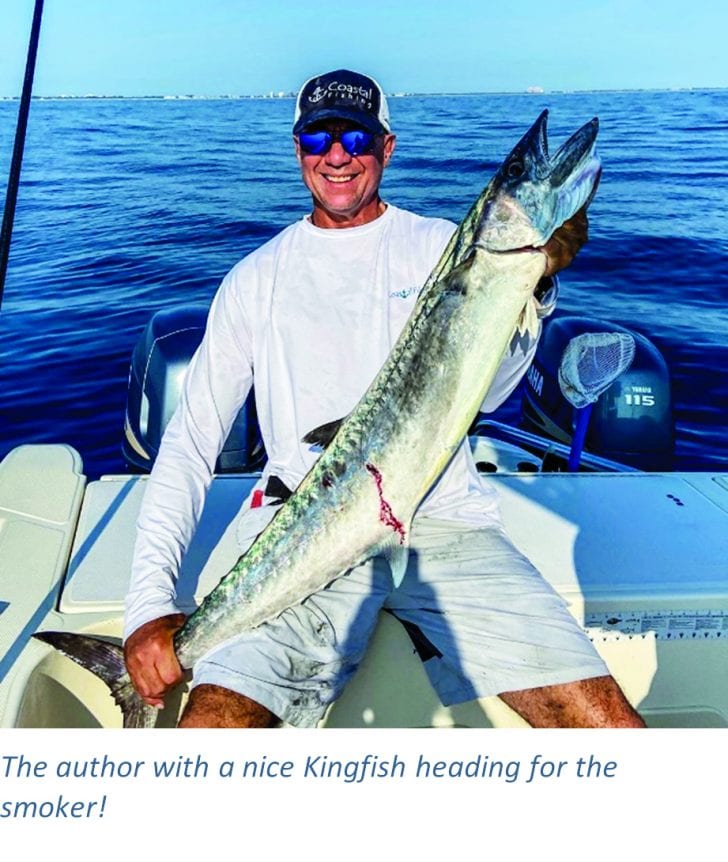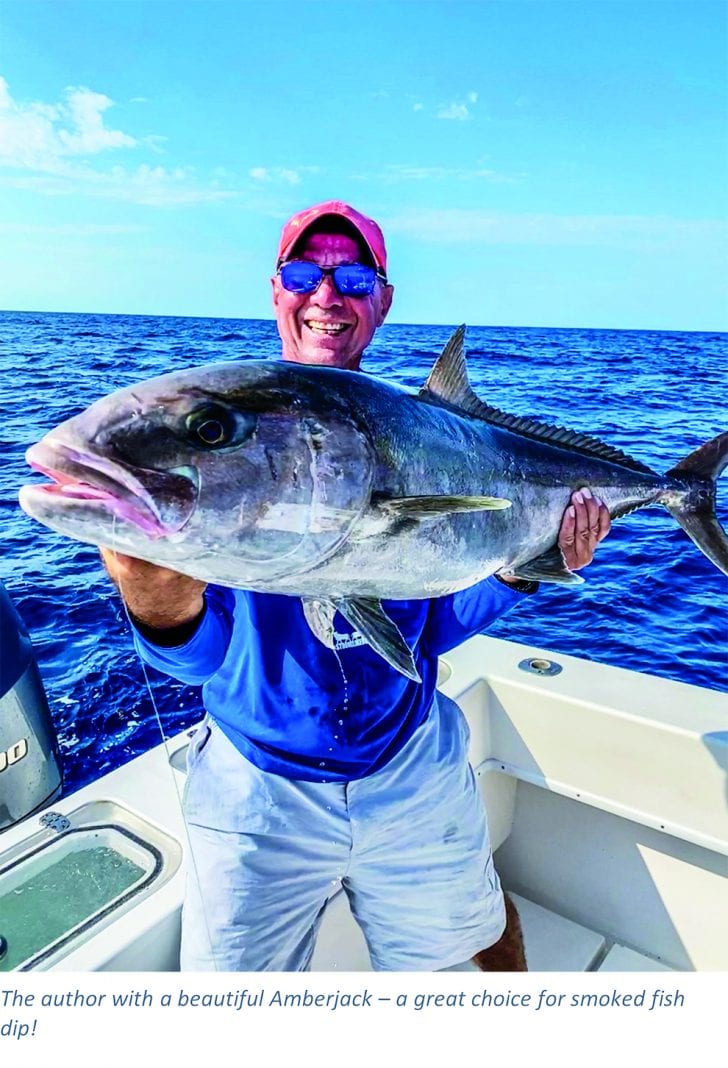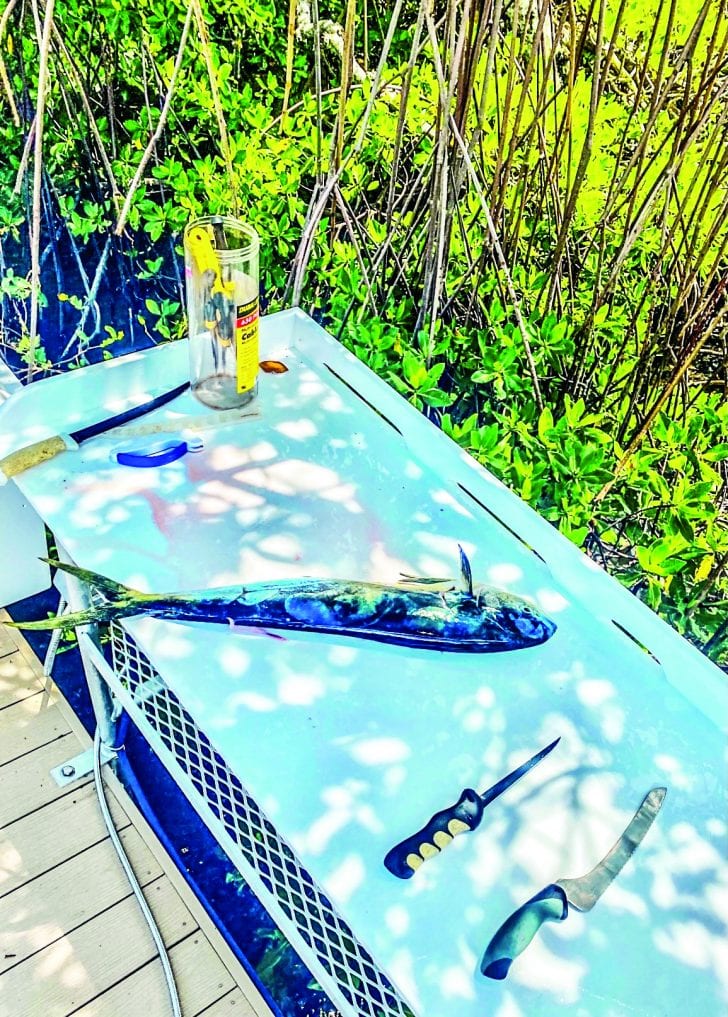By Mark Ambert Contributing Writer
Kingfish, mackerel, jack crevalle, bluefish, amberjack – often overlooked as target food species these fish while highly regarded for their fighting capabilities are shied away from or even thrown back when it comes to table fare. Don’t overlook the food potential of these tasty fish. When properly prepared, get ready to eat the most amazing and flavorful treat – fresh smoked fish! As such, they can be transformed into one of the best tasting dishes and a true culinary delight! And for those unable or willing to invest in a smoker, the preparation techniques still apply for preparing fish for the table. I’ve also included a recipe for fresh fish dip that doesn’t require a smoker. I’ll take a step by step approach on how to prepare so let’s begin.
Introduction – Once caught, proper handling and care of fish is the single most important step to insuring the flavor of this delicate meat. It can help to preserve the taste regardless of how it’s prepared for the table. First, we’ll cover the basics for ensuring your catch maintains its freshness then focus on how to prepare for the table. I’ve broken preparation down to a three-step process. It all begins with the handling. Most of what I’ll outline here can be used in the preparation of any fresh caught fish.
Step 1 – Proper care begins with bringing the fish onboard. If you decide to gaff your fish, make sure not to damage the delicate meat. Try and place your gaff as close to the head as possible. Once on board the best thing to do is to dispatch the fish quickly by placing it upside down in a bucket of saltwater and cutting the gills or straight across in between. This will facilitate a quick and humane demise and preserve the flavor of the fish. This should be done for all fish caught before icing it down.
Step 2 – Proper icing entails more than just placing the fish in a cooler or fish box. I like to use a combination of fish box and fish bag or a well-insulated cooler to preserve the fish. I place the fish inside the bag with ice and some saltwater to create a cold slurry. This starts the process of food preservation for what may be a long hot day on the water and ensures the quality of the meat. If you have a cooler or well insulated fish box, you won’t need the fish bag.
Step 3 – Back at the dock proper filet technique is required to prepare for smoking or eating. I like to skin all my fish as the skin contains most of the contaminates and removal helps preserve the flavor. I remove all the blood lines and trim the meat to size. If you see any dark areas or bloodlines remove them! You can then filet or steak the fish — your choice. I usually do a bit of both for variety. Try not to use fresh water when cleaning the fish. I take a bucket of blue water back from the ocean or the cleanest water from where the fish is caught for cleaning purposes and only use a minimal amount as I clean. This preserves the integrity of the fish as they live in salt not fresh water and the use of fresh or too much water will degrade the quality of the meat. I also keep one gallon of clean blue saltwater for the brining process whenever possible. Bring a milk jug and fill it when out in the ocean. Once the fish have been cleaned get them on ice and ready for the brine.
A note on cleaning amberjack – some of the larger fish can be prone to parasites. I tend to only keep small to medium sized fish for this reason. Most of these parasites will be concentrated at the tail. When cleaning, cut your filets just short of the tail area and all will be well. If you see a few strays just rinse them off as they are not in the flesh of the fish. They are just unsightly and do no harm.
Part II of this article will cover the actual smoking process using an electric smoker – stay tuned!
Mark Ambert – Author – Avid outdoorsman,
sportswriter & photographer
Follow me on Instagram @marksgonefishing or contact me at marksgonefishing25@gmail.com for collaboration.
Here is a bonus recepie for preparing a smoked fish dip but without the need for a smoker!
Smoked Fish Dip
In a food processor, mix the following ingredients
• 8 oz sour cream
• 8 oz cream cheese
• 2-3 sprigs of dill
• 5 generous shakes of Old Bay
• ¾ of a fresh lemon or lime
• Salt and pepper to taste
• 1 tablespoon garlic powder
• 1 tablespoon onion powder
• 1 diced jalapeno
Break up and add smoked fish in pieces, not too small. Slowly pulse the mixture in a food processor or by hand in a mixing bowl until the desired texture is reached. I don’t like mine too creamy so mix to taste!
Dip Tip — If you do not have a smoker to smoke the fish, cube then boil the fish for ten minutes in a pot on the stove. Once mixed in a bowl, use smoke seasoning to taste such as Liquid Smoke to add that smoky flavor.
I like to mix two types of fish when making a dip. The first type would be a dry white fish like amberjack. The second would be an oily fish like kings or bluefish. Combining the two brings out a whole new flavor and texture to the dip! Now prepare the dip for serving by chilling in the fridge for two hours. Spread on a cracker and enjoy!



